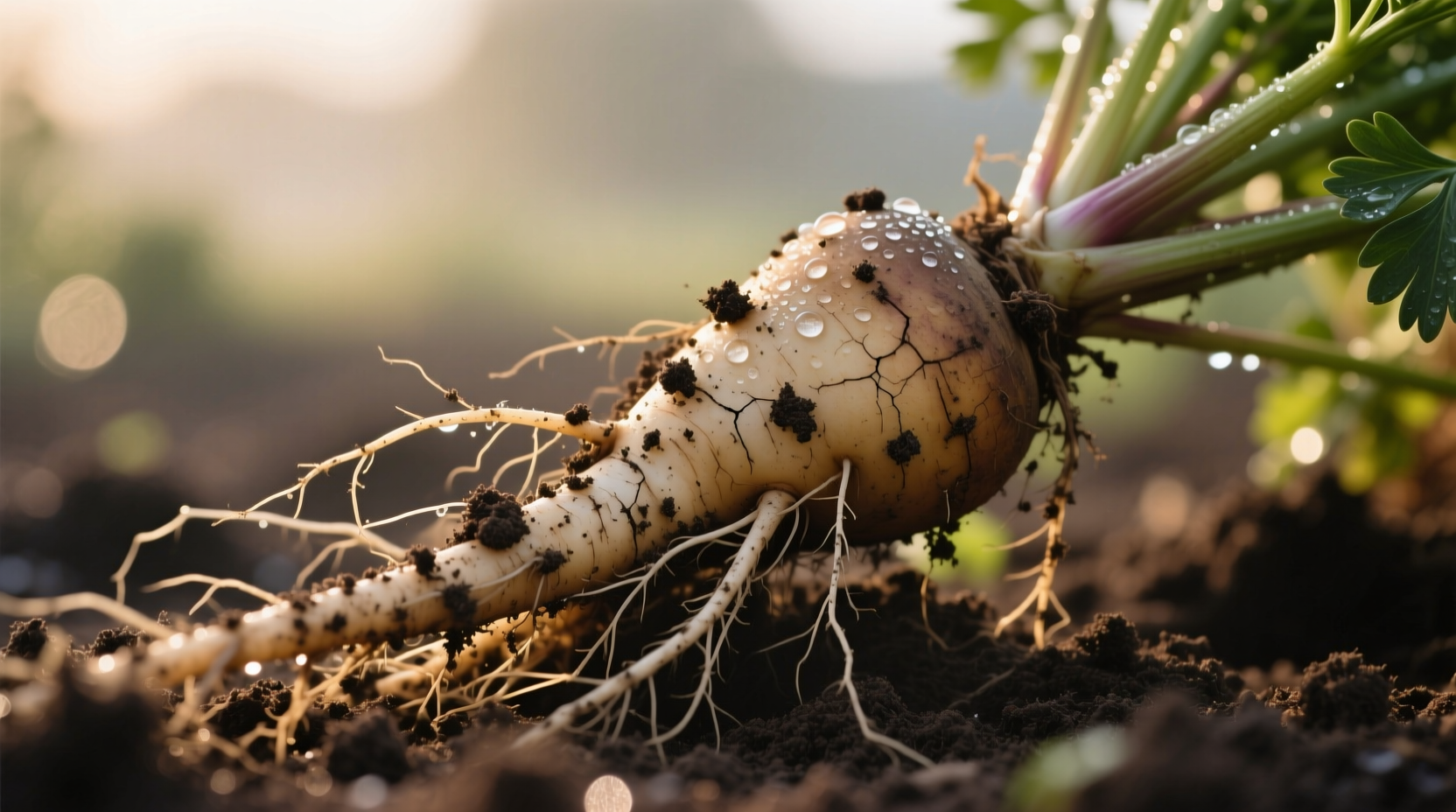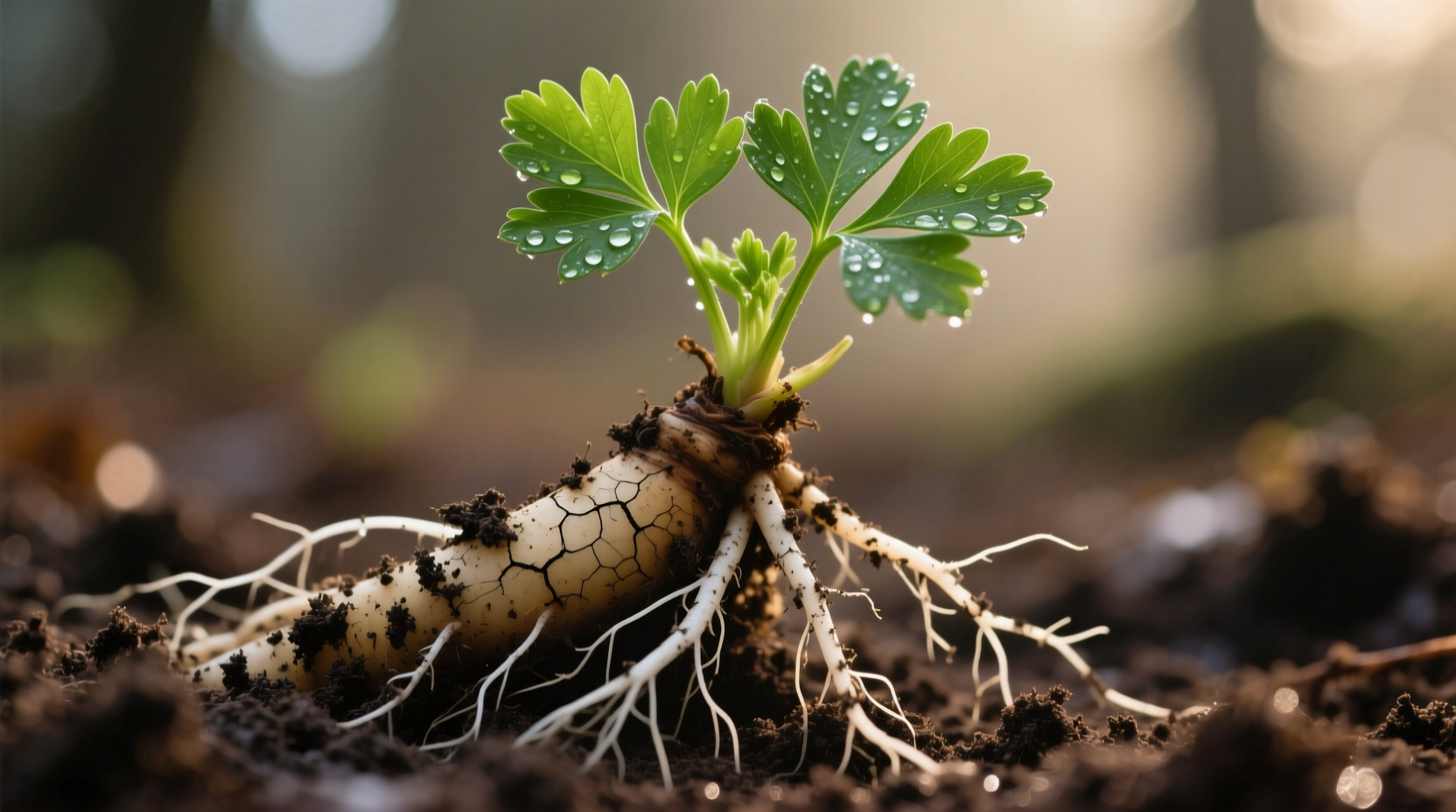While most Americans recognize parsley only as a decorative green garnish, root parsley has been a staple in Central and Eastern European kitchens for centuries. Unlike its leafy cousin, this variety develops an edible taproot that adds subtle earthy notes to soups, stews, and roasted vegetable medleys. Understanding this versatile ingredient opens doors to authentic preparations of traditional dishes from Germany, Poland, and the Czech Republic.
What Exactly Is Root Parsley?
Root parsley belongs to the same botanical family as carrots and celery (Apiaceae), but forms a distinct taproot rather than the feathery leaves of common parsley. The root resembles a pale parsnip or small turnip, typically measuring 3-6 inches in length with a creamy white to pale yellow skin. Its interior flesh is crisp and juicy with a flavor profile that combines mild celery notes with subtle parsley undertones and a hint of nuttiness.
| Characteristic | Root Parsley | Leaf Parsley |
|---|---|---|
| Botanical Variety | Petroselinum crispum var. tuberosum | Petroselinum crispum var. crispum/neapolitanum |
| Primary Use | Root vegetable for cooking | Herb for garnish/flavoring |
| Flavor Profile | Mild celery-parsley hybrid, slightly nutty | Strong herbal, grassy notes |
| Texture | Crisp, firm root (similar to parsnip) | Tender, delicate leaves |
| Storage Life | 2-3 weeks refrigerated | 3-5 days refrigerated |
Historical Journey of Root Parsley
Root parsley's culinary journey spans centuries, evolving from medicinal plant to kitchen staple. Historical records from the USDA Agricultural Research Service document its transition from apothecary gardens to dinner tables:
- 16th century: First documented cultivation in German monastic gardens as a medicinal plant
- 18th century: Adopted by Central European peasants as a hardy winter vegetable
- 19th century: Became integral to traditional dishes across Prussia, Austria-Hungary, and Russia
- Early 20th century: Featured in classic cookbooks like Polish National Cookery (1929) as a soup base
- Post-WWII: Declined in Western Europe but remained staple in Eastern Bloc countries
- 21st century: Experiencing revival among chefs focused on heirloom ingredients
Where Root Parsley Shines: Culinary Applications
Unlike leaf parsley that loses flavor when cooked, root parsley's subtle notes actually intensify with heat, making it ideal for slow-cooked preparations. The University of Copenhagen's Department of Food Science confirms that root parsley maintains 85% of its volatile compounds during simmering, compared to just 40% for leaf varieties.
Professional chefs in Berlin and Warsaw consistently use root parsley in these applications:
- Soup foundations: Forms part of the "mirepoix" equivalent in German "Suppengrün" (along with carrots and celery)
- Roasted vegetable medleys: Holds shape better than potatoes with less sweetness than parsnips
- Root vegetable purees: Creates silky texture without overpowering other flavors
- Stocks and broths: Imparts subtle herbal notes without the bitterness of overused leaf parsley
- Pickled preparations: Absorbs vinegar flavors while maintaining crisp texture

Practical Usage Guide for Home Cooks
When selecting root parsley at farmers markets or specialty grocers, look for firm roots without soft spots or excessive branching. The USDA Produce Market Guide recommends choosing specimens under 1 inch in diameter for optimal tenderness.
Preparation Techniques
Unlike parsnips, root parsley rarely requires peeling—simply scrub thoroughly with a vegetable brush. Its thin skin contains concentrated flavor compounds that would be lost through peeling. For raw applications like salads:
- Soak in ice water for 15 minutes to enhance crispness
- Julienne or use a mandoline for paper-thin slices
- Pair with lemon vinaigrette to highlight its subtle notes
Storage Recommendations
Proper storage significantly extends root parsley's shelf life. Research from the Postharvest Technology Center at UC Davis shows that root parsley maintains quality for 18-21 days when stored correctly:
- Remove leafy tops immediately after purchase (they draw moisture from the root)
- Store unwashed in perforated plastic bag with damp paper towel
- Keep in vegetable crisper drawer at 32-36°F (0-2°C)
- Never store near ethylene-producing fruits like apples or bananas
Regional Usage Patterns
Root parsley's culinary significance varies dramatically by region, reflecting historical agricultural practices and flavor preferences. Analysis of European culinary traditions reveals distinct usage patterns:
- Germany/Poland/Czech Republic: Considered essential soup vegetable (92% of traditional recipes include it)
- France/Italy: Rarely used (less than 3% of traditional recipes feature it)
- United States: Primarily found in specialty markets (appears in less than 1% of mainstream recipes)
- Russia/Ukraine: Used in winter storage preparations (pickled or fermented)
This regional disparity explains why many American cooks remain unfamiliar with root parsley despite its European prominence. Culinary anthropologists note that post-WWII food industrialization in Western Europe favored more visually consistent vegetables, contributing to root parsley's decline outside Eastern Europe.
Substitution Guidance
When root parsley proves unavailable, these substitutions work depending on your recipe's requirements:
- For raw applications: Celery root (celeriac) with lemon zest (use 25% less)
- For soups/stews: Combination of parsnip and regular parsley (2 parts parsnip to 1 part parsley)
- For roasting: Turnip with added celery seed (1/8 teaspoon per pound)
- For purees: Parsnip with small amount of fresh tarragon
Remember that no substitution perfectly replicates root parsley's unique flavor profile. The International Journal of Gastronomy and Food Science notes that root parsley contains distinctive sesquiterpene compounds not found in other Apiaceae vegetables, creating its characteristic earthy-celery flavor.
Reviving Traditional Knowledge
As culinary traditions evolve, preserving knowledge about heritage ingredients like root parsley becomes increasingly important. Organizations like Slow Food International have documented over 37 regional varieties of root parsley across Europe, many of which are at risk of disappearing. Home cooks can contribute to this preservation effort by seeking out heirloom varieties at farmers markets and incorporating them into traditional recipes.
Frequently Asked Questions
Can I grow root parsley in my home garden?
Yes, root parsley grows well in home gardens with loose, well-drained soil. Plant seeds directly in early spring as they require 3-4 weeks to germinate. The roots mature in 90-120 days and can remain in the ground through light frosts, which actually improves their flavor. Harvest when roots reach 1-1.5 inches in diameter for best texture.
Is root parsley the same as Hamburg parsley?
Yes, root parsley is commonly known as Hamburg parsley in European markets and recipes. The name comes from its historical prominence in German cuisine, particularly in the Hamburg region where it was widely cultivated since the 16th century. Both terms refer to Petroselinum crispum var. tuberosum.
Why isn't root parsley available in most American supermarkets?
Root parsley never gained widespread popularity in the United States due to post-WWII food trends that favored standardized produce. American supermarkets historically prioritized vegetables with longer shelf life and visual consistency. However, it's increasingly available at farmers markets, specialty grocers, and through mail-order seed catalogs as interest in heirloom vegetables grows.
Can I use the leafy tops of root parsley?
Absolutely. The leafy tops of root parsley are completely edible and have a stronger flavor than common parsley. They work well as a substitute for regular parsley in cooked dishes, though their flavor is more pronounced. For best results, add the leaves during the last 10 minutes of cooking to preserve their flavor.
Does root parsley have nutritional benefits?
Root parsley offers notable nutritional benefits including high vitamin C content (30% of daily value per 100g), significant potassium levels, and good amounts of vitamin B6 and folate. Unlike leaf parsley, it also provides dietary fiber from its root structure. The USDA National Nutrient Database shows it contains beneficial antioxidants called apigenin and luteolin that support cardiovascular health.











 浙公网安备
33010002000092号
浙公网安备
33010002000092号 浙B2-20120091-4
浙B2-20120091-4